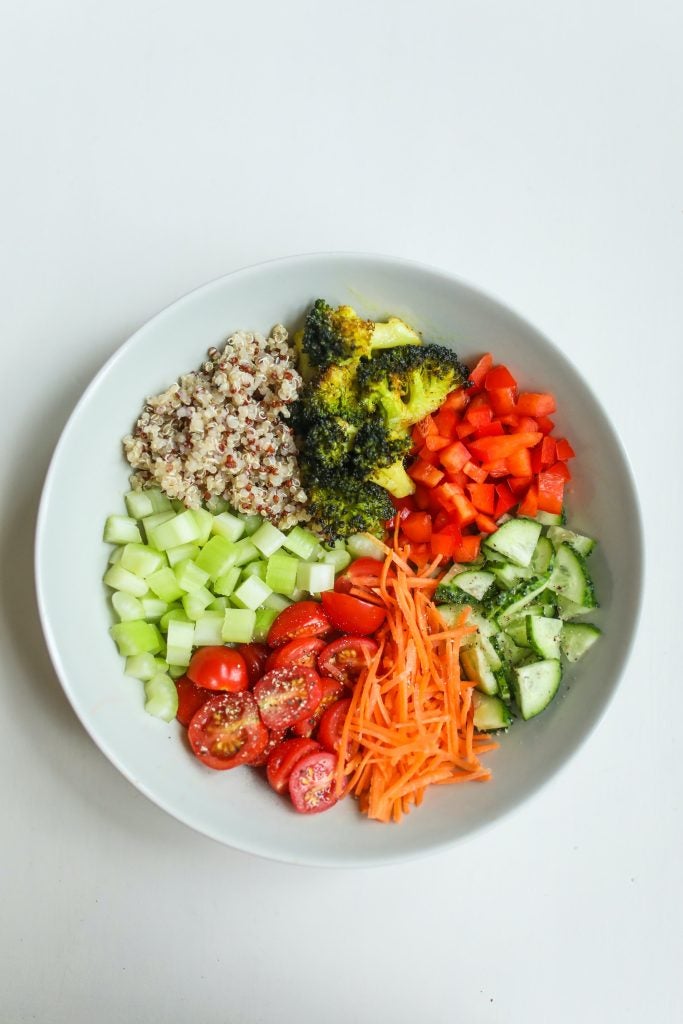
Healthy eating involves knowing what foods your body needs to function optimally, what foods you enjoy consuming, and finding a balanced variety of the two that keeps your body and mind both strong and satisfied.1 The following sections aim to help you understand the various aspects of healthy eating so that you can both reflect on your intentions for wanting to eat healthy and familiarize yourself with tips experts suggest for having a healthy and balanced lifestyle.
Table of Contents
Reflect on Your Motives
Healthy choices regarding what you consume can bring many benefits into your life, including lowering the risk of heart disease, cancer, and other chronic disorders, as well as maintaining a healthy weight to help you feel your best.2 With that said, there are still many other reasons people choose to eat healthy that do not always pertain to the benefits listed above. For example, many people who weight train or compete in body building competitions choose to track their macronutrient consumption and create diet plans in order to gain muscle mass and sculpt their body. There are also many athletes, professional and unprofessional, who understand that healthy eating choices will allow them to perform their best in whatever sport they play. Other times, people choose to eat healthy because they are unhappy with their physical appearance and would like to change the way they look by manipulating their diet.
Though there are not necessarily “good” or “bad” reasons for eating healthy, make sureto evaluate your motives behind wanting to have a balanced diet. Generally, having a healthy, balanced diet can be a great addition to your life. However, if your motives for wanting to eat healthy stem from unhealthy cognitions and tendencies, it is important to recognize these tendencies so that you can simultaneously combat them while adjusting to a healthier lifestyle. Motivations such as feeling uncomfortable in your own skin, having a negative body image, or feeling pressured by others to change your appearance may cause you to overly restrict yourself when dieting. You may also experience psychological distress or eating disorders. If this is the case, consider utilizing other resources and methods, in addition to eating healthy, that can foster a happier, healthier lifestyle. Such resources can include counseling or therapy, practicing self-love techniques, journaling your thoughts, doing research regarding the causes of negative body image and how to cope with it, reading positive body image blogs and articles, and more. If you would like to learn more about how to attain a positive body image, consider reading our articles “Improving Your Body Image,” “18 Steps to Improving Your Body Image,” or “Looking Past Body Image to Enjoy Your Sex Life.” The goal is to love your body and be comfortable in your skin, while simultaneously taking actions to improve your health and well-being, which includes having a balanced, nutritious diet.
The 80/20 Rule
Changing your diet in order to obtain a healthier lifestyle or maintaining a balanced diet can be difficult at times due to unhealthy food cravings. One technique is to follow the food guide pyramid to make healthy choices eighty percent of the time, and eat what you want the other twenty percent of the time; all foods can be a part of healthy eating.1 There are no “good” or “bad” foods, and enjoying variety of foods can help prevent feelings of guilt, binging, or giving up.1 For most Americans, following the 80/20 rule is both an improvement to their current habits and an obtainable goal. Below is a photo of the recommended portion size of foods on the food guide pyramid to use when trying to make healthier choices during the mentioned eighty percent of times.
Keys to a Healthy Diet
Healthy eating does not have to be confusing or overly restrictive.2 It also does not mean that all the foods you eat have to be bland or tasteless. Below are some simple guidelines to help focus on what types of foods to eat, listed in no particular order.
- Keep portion sizes moderate, especially for high calorie foods.2 Calories are not bad for you; your body needs calories to function. However, consuming too many calories can be detrimental. Moderation and portion sizes are essential to healthy eating – you do not want to eat too much, but you also do not want to eat too little. Refer to the “Listen to Your Body” section below to learn more about when to start eating and when to stop eating.
- Look at nutrition labels when purchasing food. The first thing you should look at when reading nutrition labels at the grocery store is the serving size.3 Before comparing the macronutrients of various products, check the amount for one serving (serving size) under “Nutrition Facts.” Also, make sure to accurately convert the portion size before choosing which product is the healthier option.3 For example, one box of cookies could have a serving size of ten ounces and list the macronutrients per ten ounces of its cookies, while another box of cookies could have a serving size of 15 ounces and list the macronutrients per 15 ounces of its cookies. Comparing the nutrients of these two products without accommodating to the different portion sizes will give you an inaccurate depiction of the differences between the nutritional value of these two options.
- Limit fat, cholesterol, and sodium consumption. Eating less of these nutrients could help reduce risk for heart disease, high blood pressure, and cancer.3 Fat can be broken down into three different types: saturated, polyunsaturated, and monounsaturated fat.3 Unsaturated fats are considered the “good” fats that could potentially provide health benefits if consumed in moderation (e.g., fatty fish helps reduce the risk of heart disease and has other benefits).2 Examples of foods that contain unsaturated fats include fish, avocado, nuts, and vegetable oil.2 Though foods with unsaturated fat may provide health benefits, consume these high-fat foods in place of other fatty foods to avoid overconsumption of calories in your diet.2 Other fats, including saturated and trans fat, are linked to an increased risk of heart disease and should be avoided when possible.3 Sodium should also be avoided in excess because high levels can cause high blood pressure and other harmful effects.2 While minimizing sodium intake, aim to consume more potassium-rich foods as they lower blood pressure.2 Such foods include citrus fruits, bananas, potatoes, beans, and yogurt.
- Consume vitamins and minerals from foods as much as possible. The body requires vitamins and minerals (also called micronutrients) in order to function properly as they facilitate vital processes and promote overall good health.2 Though taking these micronutrients in supplement form may provide benefits, studies have found that supplements yield disappointing or inconsistent results, so it is better to consume vitamins and minerals from foods.2
- Focus on high-fiber foods. Foods such as vegetables, fruits, and whole grains are high in fiber and are considered “good” carbohydrates that are nutritious, filling, and low in calories.2 These types of foods usually contain essential vitamins, minerals, and other important nutrients that can bring great health benefits.
Though these key points do not portray all of the possible ways to practice a healthy diet, we hope that by following these guidelines, your body will become nourished with the nutrients it needs to help you live a happy and successful life. The goal is to feed your body with the nutrients it needs to survive, while not over-limiting yourself from eating foods you enjoy. This leads us to our next section below, that focuses on understanding the signals your body gives you when you are hungry and full.
Listen to Your Body
Following an overly strict diet can be tiresome and difficult, which is why diets are generally depicted as a chore or a negative experience. An important point to keep in mind when dieting is that your body needs food for energy in order to function and perform optimally. Food is fuel for your body.4 Your body will usually portray signs that it needs more fuel or if it is running low on energy – listen to your body when it is telling you to respond to your natural hunger.4 Such signs include, but are not limited to, a growling stomach, a headache, fatigue, or constant obsession over food.
After listening to your body and being able to detect (and respond to) hunger, it is also important to know when your body has consumed enough food.4 Feelings of fullness indicate that your body has consumed enough food in order to function; the goal is to feel content from your food, not uncomfortably stuffed.4 Practicing conscientious techniques while eating may also help with this process: be aware of what you are eating, eat while sitting down (as opposed to standing), chew slowly, and enjoy the taste of your food.4
Concluding Remarks

There are many benefits to healthy eating, such as an increase in overall health benefits, a lower risk of life-threatening diseases, and the chance to live a happier lifestyle. Though healthy eating can improve various aspects of life, to reflect on your motives for wanting to practice healthy eating before you begin dieting. If your motives for dieting are tied to unhealthy cognitions or a negative body image, this may cause you to over-restrict yourself when dieting, which can lead to harmful psychological (or physical) consequences, including eating disorders. If this is the case, we urge you to utilize other sources and methods to practice self-love and live a happier, healthier lifestyle while embarking on your journey to practicing eating healthy. Healthy eating is only one component of living a balanced, fulfilling lifestyle, and if other aspects of your life are fostered in the same way your diet is, the results can be extremely rewarding.
References
- “Health & Wellbeing.” Mark Shishim. 2016.
- “Eat well, be well: 15 keyes to a healthy diet, plus other essential advice.” News and expert advice from the School of Public Health: Special food & Nutrition Issue. University of California, Berkeley Wellnes Letter. Vol 28 (11). Summer 2012.
- “Eat Right. Food, Nutrition and Health Tips from the American Dietetic Association.” Eat right, American Dietetic Association. 2009.
- “Listen to Your Body. Eat when you are truly hungry. Stop when you are full.” National Eating Disorders Association. 2005.
Last updated: 29 May 2018.
